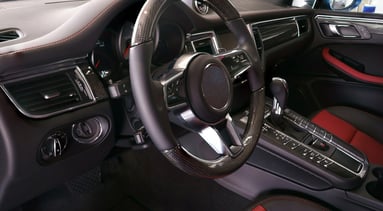What to Know When Servicing HPS Systems
 We're currently in a period of transition in the power steering industry. A variety of different steering systems are still common on the road today, including plenty of cars still using hydraulic power steering units. As recently as 2005, HPS systems were installed in over 50% of cars produced in Europe, Japan, Korea, and North America. While that number is changing today, plenty of those models are still on the road, and in need of service, today.
We're currently in a period of transition in the power steering industry. A variety of different steering systems are still common on the road today, including plenty of cars still using hydraulic power steering units. As recently as 2005, HPS systems were installed in over 50% of cars produced in Europe, Japan, Korea, and North America. While that number is changing today, plenty of those models are still on the road, and in need of service, today.
But what exactly does it take to service HPS today when you're also dealing with electronic and hybrid technology? In this post, we'll explain what to know when servicing HPS systems as well as how the modern shift in steering tech should make a difference in your shop.
What's Inside an HPS System?
 The design of hydraulic power steering units is based mainly on mechanical components. Input from the driver generates hydraulic pressure by pumping fluid to one side of the unit, which provides steering assist.
The design of hydraulic power steering units is based mainly on mechanical components. Input from the driver generates hydraulic pressure by pumping fluid to one side of the unit, which provides steering assist.
Here are some of the main components of every HPS system:
- Rack and pinion: The rack and pinion make up the interface that translates steering input into the movement of the vehicle's wheels. As the wheel is turned, the pinion attached to the end of the input shaft rotates and pushes the rack in the desired direction.
- Steering pump: The steering pump is driven by the engine through a belt and produces the hydraulic pressure that runs the system. This pump controls the flow of power steering fluid through valves that open when the steering wheel is turned.
- Hydraulic cylinders: The steering pump sends the hydraulic fluid into a pair of hydraulic cylinders in the rack and pinion to make for easy turning.
- Steering hose: The power steering hoses connect the steering pump to the cylinders that allow it to turn the wheels. The two main steering hoses are the high side and low side hoses. The high side hose carries power steering fluid under pressure to the rack, while the low side hose carries low pressure fluid back to the pump.
- Tie rods: Tie rod ends attach the ends of the steering rack to the steering knuckle, and are responsible for allowing the motion of the rack to turn the front wheels. They also help absorb road shock if the vehicle encounters uneven roads and the wheels bounce.
What You Should Know When Diagnosing and Servicing HPS Systems
As with any other repair or rebuild job, servicing HPS successfully depends on careful inspection and diagnosis. Here are some of the most important things you should remember when working with HPS systems in your shop.
 Always check fluid levels. One of the most common causes of HPS failure is low power steering fluid levels. Without steering fluid, the system isn't able to generate the hydraulic pressure that assists steering. The first step of any HPS service should be to check fluid levels. If levels are low, add the correct type of fluid to see if this corrects the steering issues.
Always check fluid levels. One of the most common causes of HPS failure is low power steering fluid levels. Without steering fluid, the system isn't able to generate the hydraulic pressure that assists steering. The first step of any HPS service should be to check fluid levels. If levels are low, add the correct type of fluid to see if this corrects the steering issues.- It's critical to bleed the system during service. Air trapped in the steering system can cause increased steering effort and noise. If groaning sounds persist or quit for a short time before returning, this is a sign of air in the system. Additionally, foamy steering fluid could be another sign of air trapped in the system. If you're replacing the steering pump or hose, it's always important to flush and bleed air from the system by turning the steering wheel lock to lock several times. This will remove unwanted air in most vehicles.
- Inspect hoses and lines for leaks. Another major cause of HPS issues is a steering fluid leak. If fluid is consistently low in a particular vehicle, it's likely that the system is leaking fluid from one or more hoses or lines. Any leaking components should be replaced to prevent fluid from leaking out and contaminants from getting in.
- Replace all wear parts. A complete HPS rebuild means replacing all wear parts in the steering system. Because HPS is a largely mechanical system, many parts are likely to wear out over time, including hoses, pumps, and even the sealing components that hold the system together.
- Check for loose belts. Screechy sounds while steering are a sign of a loose belt between the engine and the steering pump.
 HPS and the steering industry are changing. Finally, it's important to be aware of the changing steering industry and what this means for future HPS service. The automotive industry overall is in a period of electrification, and this trend toward electric technologies extends into the steering industry. In the past few years, we've seen the majority of manufacturers switching to electronic power steering (EPS) and hybrid steering technologies while HPS installation is decreasing. While HPS units will probably still be on the road for several more years, the overwhelming trend for late-model vehicles is towards EPS. It's only a matter of time until most of the vehicles in your shop are using EPS instead of HPS, and now is the time to start preparing your technicians and your business for the transition.
HPS and the steering industry are changing. Finally, it's important to be aware of the changing steering industry and what this means for future HPS service. The automotive industry overall is in a period of electrification, and this trend toward electric technologies extends into the steering industry. In the past few years, we've seen the majority of manufacturers switching to electronic power steering (EPS) and hybrid steering technologies while HPS installation is decreasing. While HPS units will probably still be on the road for several more years, the overwhelming trend for late-model vehicles is towards EPS. It's only a matter of time until most of the vehicles in your shop are using EPS instead of HPS, and now is the time to start preparing your technicians and your business for the transition.


